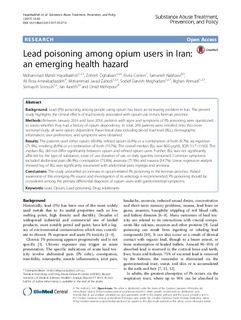| dc.contributor.author | Hayatbakhsh, Mohammad Mahdi | |
| dc.contributor.author | Oghabian, Zohreh | |
| dc.contributor.author | Conlon, Elvira | |
| dc.contributor.author | Nakhaee, Samaneh | |
| dc.contributor.author | Amirabadizadeh, Ali Reza | |
| dc.contributor.author | Zahedi, Mohammad Javad | |
| dc.contributor.author | Moghadam, Sodief Darvish | |
| dc.contributor.author | Ahmadi, Bighan | |
| dc.contributor.author | Soroush, Somayeh | |
| dc.contributor.author | Aaseth, Jan | |
| dc.contributor.author | Mehrpour, Omid | |
| dc.date.accessioned | 2018-02-12T07:32:20Z | |
| dc.date.available | 2018-02-12T07:32:20Z | |
| dc.date.created | 2017-10-09T11:03:12Z | |
| dc.date.issued | 2017 | |
| dc.identifier.citation | Substance Abuse Treatment, Prevention, and Policy. 2017, 12 (1), . | |
| dc.identifier.issn | 1747-597X | |
| dc.identifier.uri | http://hdl.handle.net/11250/2483920 | |
| dc.description.abstract | Background Lead (Pb) poisoning among people using opium has been an increasing problem in Iran. The present study highlights the clinical effects of lead toxicity associated with opium use in Iran, Kerman province. Methods Between January 2016 and June 2016, patients with signs and symptoms of Pb poisoning were questioned to assess whether they had a history of opium dependency. In total, 249 patients were enrolled onto this cross-sectional study, all were opium dependent. Para-clinical data including blood lead level (BLL), demographic information, user preferences, and symptoms were obtained. Results The patients used either opium (83.9%), refined opium (6.4%) or a combination of both (9.7%) via ingestion (71.9%), smoking (8.4%) or a combination of both (19.7%). The overall median BLL was 80.0 μg/dL [IQR: 51.7–119.0]. The median BLL did not differ significantly between opium and refined opium users. Further, BLL was not significantly affected by the type of substance, route of use, duration of use, or daily quantity consumed. Common symptoms included abdominal pain (86.9%), constipation (75.8%), anorexia (71.5%) and nausea (54.7%). Linear regression analysis showed log of BLL was significantly associated with abdominal pain, myalgia and anorexia. Conclusions The study unravelled an increase in opium-related Pb poisoning in the Kerman province. Raised awareness of this emerging Pb source and investigation of its aetiology is recommended. Pb poisoning should be considered among the primary differential diagnosis of opium users with gastrointestinal symptoms. | |
| dc.language.iso | eng | |
| dc.title | Lead poisoning among opium users in Iran: an emerging health hazard | |
| dc.type | Peer reviewed | |
| dc.type | Journal article | |
| dc.description.version | publishedVersion | |
| dc.source.pagenumber | 8 | |
| dc.source.volume | 12 | |
| dc.source.journal | Substance Abuse Treatment, Prevention, and Policy | |
| dc.source.issue | 1 | |
| dc.identifier.doi | 10.1186/s13011-017-0127-0 | |
| dc.identifier.cristin | 1503275 | |
| cristin.unitcode | 209,98,40,4 | |
| cristin.unitname | Institutt for sykepleie | |
| cristin.ispublished | true | |
| cristin.fulltext | original | |
| cristin.qualitycode | 1 | |
